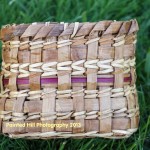Speckled Fish People: Traditional Basket Making Part II

My last blog post introduced you to basket making of the Arrow Lakes or Sinixt people. I want to take you from the coiled baskets made of cedar root and the folded cedar bark baskets to tule baskets and mats. Tule is the tall, hollow stem of the cattail which was not only a prized material for various purposes, but also a valued item of trade.
Basket makers began collecting their materials in the summer months. Every twig, root, and grass was harvested when they were at their peak. Roots and twigs were soaked, peeled, and spit while grass was cured and sometimes dyed. It was said that by the time the woman or young girl was ready to start the basket, which was in the winter months, that half the work was already done.
Colored grasses were the equivalent to embroidery silks and were among the weavers most valued possession. The Arrow Lakes women would travel high into the mountains for the shiny bear grass and most likely pick berries at the same time.
The Native women used tule stems strung together for mats. The women paddled around in canoes during July and August to gather the tule from quiet streams and lakes. They would then dry them in the sun. In the winter months, the women would string together the tule stalks that were laid side by side using string made from nettle fiber.
Small mats, three to four feet long, were used as cushions for sitting in the house and in canoes. Medium-sized mats were used as mattresses, table coverings, rain capes, and umbrellas. They were also folded for pillows. Large mats, five feet by twenty feet, were used along the walls as insulations and hung for room dividers. In addition, mats were strung together for dresses and capes for the women. Mat making was a part of basketry. Every woman had at least as many mats as baskets.
Here are five basket facts of the Arrow Lakes people:
1. Different types of baskets were used for cooking, food gathering and storage, and carrying water.
2. Overlay was the method used with tule. Dyed bear grass was interlaced on the outside of the basket creating bright patterns. A variety of edging was used by the women, but scalloped edges were favored.
3. Women would sit for weeks at a time with their materials surrounding them in the winter making their baskets and teaching the young.
4. There were three methods used for creating baskets: twining (crisscross), plaiting (checker weaving), and coiling.
5. Some of the dyes used to color the bear grass were: Oregon grape root or Lichen (yellow), swamp mud (black), cherry bark, nettle, or alder bark (red), huckleberries or blueberries (purple), Salal berries (dark blue), and willow bark (brown).
Here is a good link to use for further information:
Basket Making
Haiku poem: Traditional Basket Making
Weft tightly woven
Bright hues illuminated
Cherish the old ways
Lakes Language as taught to me by Elder Marguerite Ensminger as seen in Change of Heart by Carmen Peone.
Skumhist Black Bear
Skum (scum)- hist (rhymes with beast)
Mistum Father
Mist- um (rhymes with gum)
What kinds of arts and crafts do you like to participate in?
